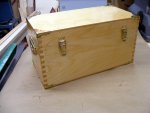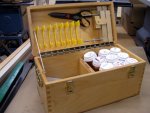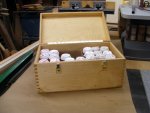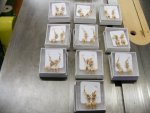- Messages
- 789
- Location
- Central North Carolina
Last week I made these boxes to keep my scroll saw blades and small hand tools that I use when working on the scroll saw all together and better organized They are similar to other "dedicated use" custom tool boxes that I've made over the years to keep special tools and their accessory parts together in one place. The third box with the black handle was made to keep my Kyrmi Original Mini Fence jig and it's accessory parts together. This is kind of a box joint jig for making very small 1/8"and /16" box joints, but it isl also great for making decorative inlay strips. All three boxes were made from Baltic Birch plywood scraps left over from a large project. I used I/2" for the box sides box jointed at the corners, and 1/4" for the tops and bottoms. I cut the box joints using an Incra I-Box jig and a Freud SBOX* blade on my Unisaw. Who ever said that "You Can't Cut Box Joints In Plywood"? It's been easy for me.
Box #1 photos 1 & 2 Is for keeping my scroll saw tools and frequently used blades together. I use 5 1/2" tall prescription pill bottles to keep my scroll saw blades organized, with a 1" round label attached to the caps to show what is inside each bottle. These bottles will hold about 3 gross of blades in bundles of I open one bundle at a time and just leave them loose in the same bottle. It's easy to slide one of the blades out with one finger when I need one. My pharmacist gives me unused bottles and caps whenever I ask for them. This box will travel with me and my scroll saw when I teach away from my shop or go to shows to do demonstrations.
Box #2 photos 3 &4 Is a little larger than box 1, but Isn't quite complete inside, but already in use. It holds all of my less ofthe used scroll saw blades, again in prescription pill bottles. It will likely remain in my shop near where I scroll saw, but may travel to larger shows.
Box #3 photo 5 with the black handle is for the Mini Fence. It's assembled and the Mini Fence is already in it, but the box has no finish on it yet, nor has the inside been partitioned yet.
Photo 6 is a close-up of one of the box joints.
I hope you like them, but if you see anything to criticize, please do so. I l learn from them, to do betterthe next time, but keep in mind that these are "tool boxes" and not meant for sale.
Charley
Box #1 photos 1 & 2 Is for keeping my scroll saw tools and frequently used blades together. I use 5 1/2" tall prescription pill bottles to keep my scroll saw blades organized, with a 1" round label attached to the caps to show what is inside each bottle. These bottles will hold about 3 gross of blades in bundles of I open one bundle at a time and just leave them loose in the same bottle. It's easy to slide one of the blades out with one finger when I need one. My pharmacist gives me unused bottles and caps whenever I ask for them. This box will travel with me and my scroll saw when I teach away from my shop or go to shows to do demonstrations.
Box #2 photos 3 &4 Is a little larger than box 1, but Isn't quite complete inside, but already in use. It holds all of my less ofthe used scroll saw blades, again in prescription pill bottles. It will likely remain in my shop near where I scroll saw, but may travel to larger shows.
Box #3 photo 5 with the black handle is for the Mini Fence. It's assembled and the Mini Fence is already in it, but the box has no finish on it yet, nor has the inside been partitioned yet.
Photo 6 is a close-up of one of the box joints.
I hope you like them, but if you see anything to criticize, please do so. I l learn from them, to do betterthe next time, but keep in mind that these are "tool boxes" and not meant for sale.
Charley











